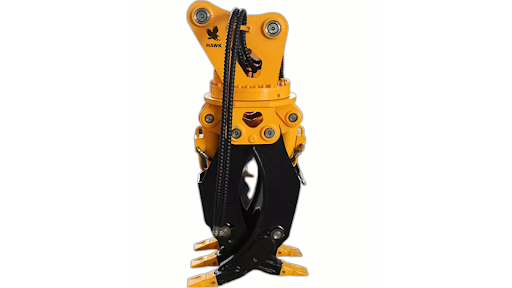Introduction
The mining industry has evolved significantly with the integration of advanced machinery and technology. Among the critical tools revolutionizing material extraction processes are hydraulic grapples. These robust attachments play a pivotal role in improving the efficiency, safety, and speed of handling various mined materials. This article explores the growing role of hydraulic grapples in mining, how they work, and how to choose and maintain them for optimal performance.
Understanding Hydraulic Grapples
Hydraulic grapples are mechanical attachments designed to grip, lift, and manipulate heavy or bulky materials using the force of hydraulics. Attached to excavators or other heavy equipment, these grapples are especially suited for environments where large-scale, repetitive handling of materials is necessary—like mining.
What Are Hydraulic Grapples and How Do They Work?
At their core, hydraulic grapples operate by using pressurized hydraulic fluid to move powerful jaws or claws. These claws can open and close to grasp materials such as ore, rocks, scrap metal, or debris. A hydraulic system connected to the host machine (usually an excavator) controls the movement and pressure applied. Operators use joystick controls to manipulate the grapple, making it possible to pick up, rotate, or release materials with precision.
Key Components of a Hydraulic Grapple System
Understanding the anatomy of a hydraulic grapple helps in both selection and maintenance. The primary components include:
- Hydraulic Cylinders: These provide the force to open and close the grapple arms.
- Rotator (optional): Allows 360-degree movement, improving maneuverability.
- Grapple Arms/Jaws: Constructed from high-strength steel to withstand heavy use.
- Mounting Bracket: Connects the grapple securely to the host equipment.
- Hoses and Fittings: Transfer hydraulic fluid from the excavator to the grapple.
Each component must be chosen and maintained carefully to ensure the tool operates efficiently and safely.
Role of Hydraulic Grapples in Modern Mining
In the fast-paced mining industry, hydraulic grapples offer a level of flexibility and control that traditional manual or mechanical tools cannot match. They are used to load and unload materials, break down oversized debris, and handle irregularly shaped or fragile loads. Their use reduces manual labor, increases speed, and minimizes the risk of injury in high-intensity mining operations.
Applications of Hydraulic Grapples in Mining
Hydraulic grapples are versatile tools with wide-ranging applications in mining:
- Material Handling: Efficiently moving large quantities of ore, coal, and aggregate.
- Debris Removal: Clearing rocks and waste from material extraction or tunneling zones.
- Loading Operations: Transferring materials onto conveyor belts, trucks, or hoppers.
- Excavation Support: Assisting in overburden removal and shaft cleaning.
- Scrap and Equipment Handling: Managing scrap metal and maintenance debris in support zones.
Their ability to function across multiple tasks makes them indispensable in large-scale mining environments.
Advantages of Using Hydraulic Grapples in Mining Operations
The benefits of using hydraulic grapples in mining go beyond just productivity:
- Increased Efficiency: Complete more work in less time with fewer resources.
- Reduced Downtime: High-strength construction and hydraulic precision reduce wear and need for frequent replacements.
- Enhanced Safety: Reduces the need for workers to manually handle heavy or dangerous materials.
- Versatility: Easily adaptable to different types of mining machinery and materials.
- Cost Savings: Long-term savings from fewer breakdowns and higher productivity.
When properly selected and integrated, grapples can significantly improve the workflow and outcomes of mining operations.
Choosing the Right Hydraulic Grapple for Mining
Selecting the ideal hydraulic grapple depends on your specific mining application. Consider the following factors:
- Type of Material: Heavier, denser materials require grapples with higher load capacities and stronger jaws.
- Machine Compatibility: Ensure the grapple is compatible with your excavator’s hydraulic system and mounting interface.
- Jaw Configuration: Options include clamshell, orange peel, and bypass grapples, each suited to different tasks.
- Weight and Size: Larger grapples can move more material but may affect the balance and hydraulic capacity of the host machine.
- Rotator Feature: If precise maneuvering is required, opt for a grapple with a 360-degree rotator.
Consulting with manufacturers or experienced suppliers such as Hawk Excavator ensures that you get a tool optimized for your specific use case.
Preventative Maintenance Tips for Longevity
Routine maintenance is key to ensuring your hydraulic grapple delivers long-term value. Tips include:
- Regular Inspection: Check for signs of wear, cracks, or hydraulic fluid leaks.
- Lubrication: Ensure all moving parts and joints are properly greased.
- Hydraulic System Checks: Monitor pressure levels and hose integrity to prevent blowouts.
- Fastener Tightness: Periodically check and tighten all bolts and fittings.
- Operator Training: Proper use reduces wear and minimizes accidental damage.
Proactive maintenance extends the service life and prevents unplanned downtime.
Conclusion
Hydraulic grapples have become a cornerstone in modern mining operations. Their power, precision, and adaptability significantly enhance the material extraction process, allowing mining companies to operate more efficiently and safely. By understanding how these tools work, their benefits, and how to maintain them, companies can make informed decisions that lead to increased productivity and lower operational costs. Investing in the right hydraulic grapple is not just a tool purchase—it’s a strategic move toward mining excellence.

